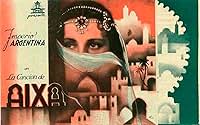Aggiungi una trama nella tua linguaTwo Muslims, members of rival families, fall in love with the beautiful half-cast Aixa at the same time.Two Muslims, members of rival families, fall in love with the beautiful half-cast Aixa at the same time.Two Muslims, members of rival families, fall in love with the beautiful half-cast Aixa at the same time.
Foto
Trama
Recensione in evidenza
It is set in Spanish Sahara , Tetuan , Morrocco , being starred by two Muslims, the religious Abslam (Manuel Luna) and the Bon Vivant called Hamed (Ricardo Merino) members of rival families , both of whom fall in love with the beautiful half-cast Aixa (Imperio Argentina) at the same time . But Hamed is forced by his father to marry Abslam's sister so that they restore the family peace . Later on , Abslam is named ¨Caid¨ or chief of ¨Cabilas ¨ and marries Axa ; then , problems ensue and things go wrong .
This is an exciting triangular love story based on the Manuel De Góngora's novel , about two Muslims both belonging to two antagonist Cabalas who fall in love for Aixa . During the Spanish Civil War the cinematic production companies were in the Republic zone - Barcelona , Madrid- and then , the Franquist govern ordered the motion pictures to be shot in Italy and Germany , particularly in UFA studios (Berlin) . In Deutschland to be made 5 pictures , the most famous were ¨Carmen La De Triana¨(1938) and this one , ¨Aixa's song¨ , both of them starred by Imperio Argentina . This is the second and last film performed and directed by the notorious duo , Imperio Argentina and Florian Rey , in city of Berlin . It tells the boring tale of romance and family confrontation , set in the Spanish Sahara , being shot in enough budget , some transparencies , abundant interiors and brief African landscapes . Here stand out the riders parades with horsemen dressed in white , some songs sung by Imperio Argentina and a spectacular musical number , a show in the harem , including a brilliant dancing titled ¨dance of the veils¨. It stars Imperio Argentina who was one of the greatest actresses of the early sound cinema , she shot his biggest hits for his husband Florian Rey in CIFESA (the most powerful production company in the dictatorship) and during II Republic , such as : ¨El Novio De Mama¨ (34) , ¨La Hermana De San Sulpicio¨(34) , a remake ¨Nobleza baturra¨(34) and ¨Morena Clara¨(36) .
This motion picture was a German/Spanish co-production by Hispano-Film-Produktion (Berlin) and being professionally directed -though with no enthusiasm- by Florian Rey . Rey was an actor , producer and director during the silent and sound cinema . He directed 40 films of all kinds of genres . His film debut as an actor was for the known director Julio Buchs . Along with filmmaker Juan De Orduña , he products and directs a Zarzuela ¨La Revoltosa¨ , his success leads him to direct for ¨Atlantida Films¨ productions 5 great films : ¨Gigantes y Cabezudos¨ (1925) based on Miguel Echegaray's Zarzuela , ¨Cura De Aldea¨(1926) , ¨La Hermana De San Sulpicio¨(27) and ¨Claveles De La Vigen¨(1928) that results to be first collaboration to Imperio Argentina , the famous rural drama ¨La Aldea Maldita¨(1930) and ¨Sierra De Ronda¨(1933) . His greatest hits were shot for Cifesa and during the Spanish Civil War accepts the invitation from the German Propaganda minister , the sinister Josef Goebbles , to shoot in Germany , there he directs ¨Carmen La De Triana¨ and this one . During post-war , separated to his muse Imperio , he goes on working and films ¨La Dolores¨ , the interesting remake ¨La Aldea Maldita¨ (41) , ¨Orosia¨(43) and ¨Brindis a Manolete¨ (48) . But his decline continues with ¨Nao Capitana¨(47) , ¨Moza Del Cantaro¨ (53) based on Lópe De Vega and ¨Polvorilla¨ (56) without successes .
This is an exciting triangular love story based on the Manuel De Góngora's novel , about two Muslims both belonging to two antagonist Cabalas who fall in love for Aixa . During the Spanish Civil War the cinematic production companies were in the Republic zone - Barcelona , Madrid- and then , the Franquist govern ordered the motion pictures to be shot in Italy and Germany , particularly in UFA studios (Berlin) . In Deutschland to be made 5 pictures , the most famous were ¨Carmen La De Triana¨(1938) and this one , ¨Aixa's song¨ , both of them starred by Imperio Argentina . This is the second and last film performed and directed by the notorious duo , Imperio Argentina and Florian Rey , in city of Berlin . It tells the boring tale of romance and family confrontation , set in the Spanish Sahara , being shot in enough budget , some transparencies , abundant interiors and brief African landscapes . Here stand out the riders parades with horsemen dressed in white , some songs sung by Imperio Argentina and a spectacular musical number , a show in the harem , including a brilliant dancing titled ¨dance of the veils¨. It stars Imperio Argentina who was one of the greatest actresses of the early sound cinema , she shot his biggest hits for his husband Florian Rey in CIFESA (the most powerful production company in the dictatorship) and during II Republic , such as : ¨El Novio De Mama¨ (34) , ¨La Hermana De San Sulpicio¨(34) , a remake ¨Nobleza baturra¨(34) and ¨Morena Clara¨(36) .
This motion picture was a German/Spanish co-production by Hispano-Film-Produktion (Berlin) and being professionally directed -though with no enthusiasm- by Florian Rey . Rey was an actor , producer and director during the silent and sound cinema . He directed 40 films of all kinds of genres . His film debut as an actor was for the known director Julio Buchs . Along with filmmaker Juan De Orduña , he products and directs a Zarzuela ¨La Revoltosa¨ , his success leads him to direct for ¨Atlantida Films¨ productions 5 great films : ¨Gigantes y Cabezudos¨ (1925) based on Miguel Echegaray's Zarzuela , ¨Cura De Aldea¨(1926) , ¨La Hermana De San Sulpicio¨(27) and ¨Claveles De La Vigen¨(1928) that results to be first collaboration to Imperio Argentina , the famous rural drama ¨La Aldea Maldita¨(1930) and ¨Sierra De Ronda¨(1933) . His greatest hits were shot for Cifesa and during the Spanish Civil War accepts the invitation from the German Propaganda minister , the sinister Josef Goebbles , to shoot in Germany , there he directs ¨Carmen La De Triana¨ and this one . During post-war , separated to his muse Imperio , he goes on working and films ¨La Dolores¨ , the interesting remake ¨La Aldea Maldita¨ (41) , ¨Orosia¨(43) and ¨Brindis a Manolete¨ (48) . But his decline continues with ¨Nao Capitana¨(47) , ¨Moza Del Cantaro¨ (53) based on Lópe De Vega and ¨Polvorilla¨ (56) without successes .
I più visti
Accedi per valutare e creare un elenco di titoli salvati per ottenere consigli personalizzati
Dettagli
- Data di uscita
- Paesi di origine
- Lingua
- Celebre anche come
- Aixa, hči pustinje
- Luoghi delle riprese
- Alcazarquivir, Kasr al-Kabir, Marocco(location shots)
- Azienda produttrice
- Vedi altri crediti dell’azienda su IMDbPro
- Tempo di esecuzione1 ora 36 minuti
- Colore
- Mix di suoni
- Proporzioni
- 1.37 : 1
Contribuisci a questa pagina
Suggerisci una modifica o aggiungi i contenuti mancanti













